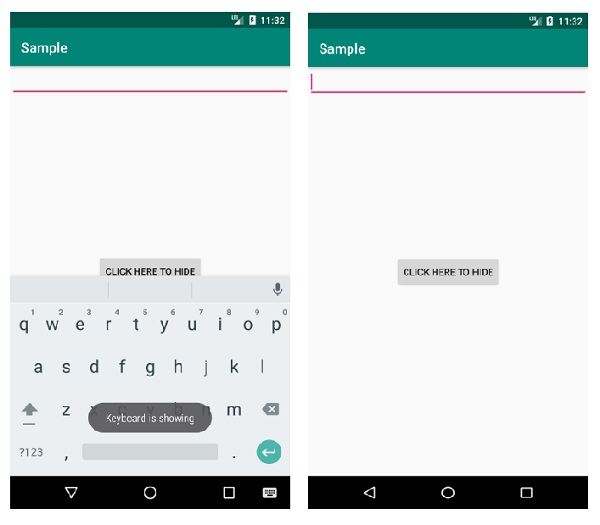
 Data Structure
Data Structure Networking
Networking RDBMS
RDBMS Operating System
Operating System Java
Java MS Excel
MS Excel iOS
iOS HTML
HTML CSS
CSS Android
Android Python
Python C Programming
C Programming C++
C++ C#
C# MongoDB
MongoDB MySQL
MySQL Javascript
Javascript PHP
PHP
- Selected Reading
- UPSC IAS Exams Notes
- Developer's Best Practices
- Questions and Answers
- Effective Resume Writing
- HR Interview Questions
- Computer Glossary
- Who is Who
How to write a SoftKeyboard open and close listener in an activity in Android?
This example demonstrates how to write a SoftKeyboard open and a close listener in activity in Android.
Step 1 − Create a new project in Android Studio, go to File ⇒ New Project and fill all required details to create a new project.
Step 2 − Add the following code to res/layout/activity_main.xml.
<?xml version="1.0" encoding="utf-8"?> <androidx.constraintlayout.widget.ConstraintLayout xmlns:android="http://schemas.android.com/apk/res/android" xmlns:app="http://schemas.android.com/apk/res-auto" xmlns:tools="http://schemas.android.com/tools" android:layout_width="match_parent" android:layout_height="match_parent" android:id = "@+id/rootView" tools:context=".MainActivity"> <EditText android:id = "@+id/editText" android:layout_width = "match_parent" android:layout_height = "wrap_content" tools:ignore="MissingConstraints"> </EditText> <Button android:id = "@+id/btnButton" android:layout_width = "wrap_content" android:layout_height = "wrap_content" android:text = "Click here to hide" app:layout_constraintBottom_toBottomOf = "parent" app:layout_constraintLeft_toLeftOf = "parent" app:layout_constraintRight_toRightOf = "parent" app:layout_constraintTop_toTopOf = "parent" /> </androidx.constraintlayout.widget.ConstraintLayout>
Step 3 − Add the following code to src/MainActivity.java
package com.app.sample;
import androidx.annotation.RequiresApi;
import androidx.appcompat.app.AppCompatActivity;
import androidx.constraintlayout.widget.ConstraintLayout;
import android.os.Bundle;
import android.graphics.Rect;
import android.os.Build;
import android.view.View;
import android.view.ViewTreeObserver;
import android.view.inputmethod.InputMethodManager;
import android.widget.Button;
import android.widget.EditText;
import android.widget.Toast;
public class MainActivity extends AppCompatActivity implements View.OnClickListener{
ConstraintLayout constraintLayout;
@Override
protected void onCreate(Bundle savedInstanceState) {
super.onCreate(savedInstanceState);
setContentView(R.layout.activity_main);
Button button = findViewById(R.id.btnButton);
EditText editText=findViewById(R.id.editText);
editText.requestFocus();
constraintLayout=findViewById(R.id.rootView);
constraintLayout.getViewTreeObserver().addOnGlobalLayoutListener(new
ViewTreeObserver.OnGlobalLayoutListener() {
@Override
public void onGlobalLayout() {
Rect r = new Rect();
constraintLayout.getWindowVisibleDisplayFrame(r);
int screenHeight = constraintLayout.getRootView().getHeight();
int keypadHeight = screenHeight - r.bottom;
if (keypadHeight > screenHeight * 0.15) {
Toast.makeText(MainActivity.this,"Keyboard is showing",Toast.LENGTH_LONG).show();
} else {
Toast.makeText(MainActivity.this,"keyboard closed",Toast.LENGTH_LONG).show();
}
}
});
button.setOnClickListener(this);
}
@RequiresApi(api = Build.VERSION_CODES.O)
@Override
public void onClick(View v) {
switch (v.getId()) {
case R.id.btnButton:
hideSoftkeybard(v);
break;
}
}
private void hideSoftkeybard(View v) {
InputMethodManager inputMethodManager = (InputMethodManager) getSystemService(INPUT_METHOD_SERVICE);
inputMethodManager.hideSoftInputFromWindow(v.getWindowToken(), 0);
}
}
Step 4 − Add the following code to Manifests/AndroidManifest.xml
<?xml version="1.0" encoding="utf-8"?> <manifest xmlns:android="http://schemas.android.com/apk/res/android" package="com.app.sample"> <application android:allowBackup="true" android:icon="@mipmap/ic_launcher" android:label="@string/app_name" android:roundIcon="@mipmap/ic_launcher_round" android:supportsRtl="true" android:theme="@style/AppTheme"> <activity android:name=".MainActivity"> <intent-filter> <action android:name="android.intent.action.MAIN" /> <category android:name="android.intent.category.LAUNCHER" /> </intent-filter> </activity> </application> </manifest>
Let's try to run your application. I assume you have connected your actual Android Mobile device with your computer. To run the app from the android studio, open one of your project's activity files and click Run ![]() icon from the toolbar. Select your mobile device as an option and then check your mobile device which will display your default screen −
icon from the toolbar. Select your mobile device as an option and then check your mobile device which will display your default screen −

Click here to download the project code.

